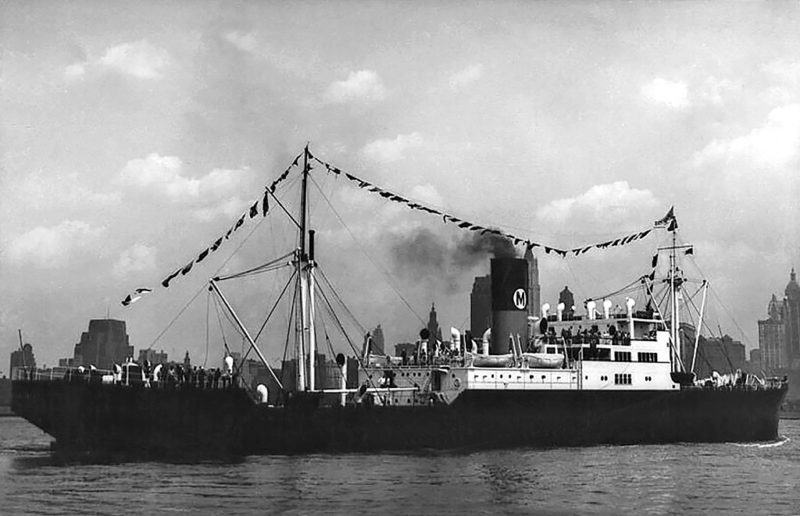
The iconic Moore-McCormack Lines was founded in New York on 9th July 1913 by Albert V. Moore (1880-1953) and Emmet J. McCormack (1880-1965) with a capital of $5,000. One small ship, Montara of 2,562 grt built back in 1881, loaded coal in 1913 at Norfolk (Virginia) for Searsport (Maine), and then moved down to Wilmington (Delaware) to load dynamite for Rio de Janeiro. Albert V. Moore lived in Hackensack (New Jersey) and Emmet J. McCormack lived in Brooklyn (New York) and both were young men when they began their partnership.
Mr. Moore came from a family of shipowners and shipmasters and obtained his early experience in the New York office of British shipowners, Bowring & Company. Profitable voyages were made by other cargo ships to Brazilian ports during World War I, including the former Great Lakers Barnstaple of 1,358 grt and Mooremack of 1,043 grt.
At the end of 1916, the first passenger ship was chartered for two years in Saga of 2,809 grt built in 1909 by Swan, Hunter & Wigham Richardson Ltd. for the Thule Line and Swedish Lloyd Line service on the North Sea between England and Sweden. Saga had been launched on 21st April 1909 at the Neptune Yard and ran her trials on 10th June 1909.
During the First World War, Saga was the only American ship sailing between American ports and Rio de Janeiro, with Brazilian industrial production doubling and agricultural diversity increasing. Later, further Swedish Lloyd Line passenger ships such as Calabria 1,825/16, Graecia 2,951/11, and Anglia 1,750/14 were taken on charter for South American services, with Anglia sinking on 18th June 1931 after a collision at San Nicolas in Argentina.
Moore-McCormack vessels averaged fifteen sailings per annum to Brazilian ports during World War I. The larger cargo ship Nantahala of 5,714 grt, built in 1918 by the Western Pipe & Steel yard at San Francisco, introduced the Mooremack flag as far south as Buenos Aires.
During 1919 and subsequent early inter-war years, 28 vessels were purchased from the vast stock of 2,311 surplus war built ships of the U.S. Shipping Board in order for them to enter commercial service, these were:-
- 15 engines ‘midships ‘Hog Islander’ cargo ships of 5,150 grt built in 1919, which kept their original names for the American Scantic Line service to Copenhagen, Oslo, Helsingfors, Polish and Russian ports, until four were converted into passenger and cargo-liners in 1932 and renamed Scanmail, Scanpenn, Scanstates and Scanyork.
- 8 engines ‘midships ‘Great Lakers’ of 2,606 grt which were built in 1919 with ‘Lake’ prefixes to their names and were renamed with ‘Commercial’ prefixes e.g. Commercial Quaker for the Mooremack Gulf Lines services from U.S. Gulf ports to Mexican ports to load fruit and other perishables for Eastern Seaboard ports.
- 5 captured German prizes of varying sizes from the Deutsche Australien Line, Hapag, Norddeutscher Lloyd, Kosmos Line and Holm & Molzen fleets and also given ‘Commercial’ prefixes to their names.
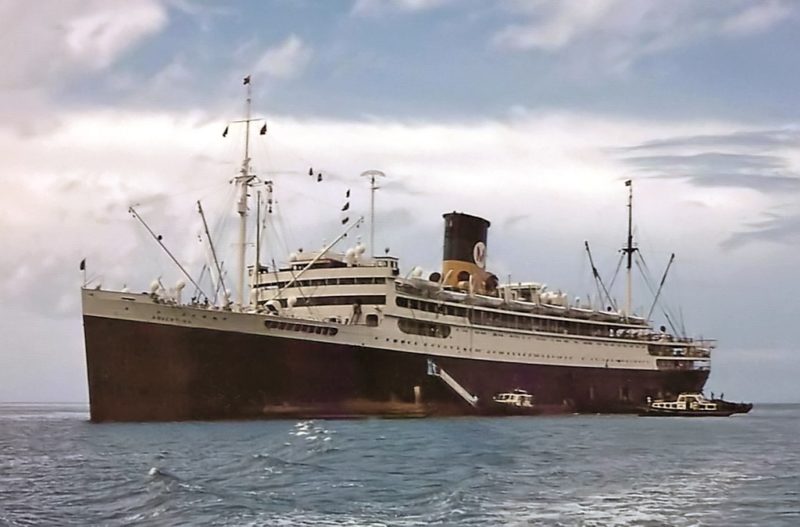
During the inter-war years, Moore-McCormack managed nine subsidiaries with various titles for various routes. In 1932, twenty ships were being managed, increased in the following year by the purchase of Crofton Hall 5,774/1913 built from the Lancashire Shipping Co. Ltd. fleet, managed by C. G. Dunn & Co. Ltd. of Liverpool, and renamed Commercial Traveler. On 8th September 1938, these nine subsidiaries were consolidated within this group to become Moore-McCormack Lines Inc.
These nine subsidiaries were:-
- American Caribbean Line with Caribbean services.
- American Republics Line with services between the Eastern Seaboard of the U.S.A. and East Coast ports of the South American countries of Brazil, Uruguay and Argentina via Barbados outward and Trinidad homeward, and with ships that were previously in the service of the Panama Pacific Line.
- American Scantic Line Inc. with services to Scandinavian and Baltic countries.
- Honolulu Steamship Co. Inc. for services to the islands of Hawaii.
- Calmar Steamship Corporation for iron ore and bulk dry cargoes.
- Mooremack Lines Inc. with services with services from U.S. ports to Caribbean.
- Mooremack Gulf Lines Inc. with services from U.S. Gulf ports to Mexico for fruit and return to Eastern Seaboard ports.
- Moore-McCormack Co. Inc. as the main holding company with services to South America, the Mediterranean, Black Sea ports, Levant countries and India.
Pacific Republics Line with cargo services between Los Angeles, San Francisco, Portland and Seattle to Central and South America.
Hull colours were either black or grey, masts and derricks were cream, while funnel colours were yellow with a green central band and a black top, with a logo on the green band that showed the various inter-war years subsidiaries.
URUGUAY, BRAZIL and ARGENTINA
Moore-McCormack Lines survived the inter-war years trading on many routes, with passenger numbers to South America sharply down to low unprofitable figures during the Depression years. The company had achieved a large fleet strength of 40 ships in 1939 serving the East Coast of South America and other world services from New York. This was helped by the granting of large amounts of economic aid to Brazil by the U.S.A., including a cheap loan to enable the Brazilian Government to build a large integrated steel mill at Volta Redonda. On 4th October 1938, as part of a consolidation of nine companies within the Moore-McCormack Group, twenty ships had been purchased from the United States Maritime Commission for $4.8 million, with the general cargo ships renamed with the ‘Mormac’ prefix to their names. This prefix was to become very familiar in post-war years for the cargo-liners, with the passenger liners continuing to use South American country names.
Three former twin funnelled passenger liners with excellent accommodation for 750 passengers were also included in the purchase. These were the Uruguay, Brazil and the Argentina. The turbo-electric trio had been built by the Newport News Shipbuilding and Dry Dock Company as California, Virginia and Pennsylvania for the New York to San Francisco service via the Panama Canal of the Panama Pacific Line. In 1937, after their subsidy had been withdrawn and Panama Canal charges had increased, the trio had been sold to the United States Maritime Commission and rebuilt for South American service with only one funnel. They ran on the American Republic Line service from American ports to South America with Moore & McCormack as managers for Uruguay, Brazil and Argentina. The American Republic Line had begun during the Depression as a trade initiative by President Franklin Roosevelt, and its funnel colours were yellow with a blue diamond between two thin black bands, the upper of which was at the top of the funnel.
The trio had an overall length of 601 feet, moulded beam of 80 feet and a loaded draft to the bottom of the keel of 32.3 feet, and a gross tonnage of over 20,000. First Class passengers numbered 386 and Tourist Class passengers numbered 363. Their turbo-electric propulsion produced 17,000 shaft horse power giving a service speed of 18 knots. First Class passengers were accommodated ‘midships over four decks, namely Boat Deck, Promenade Deck, Upper Deck and Main Deck, with the Tourist Class passengers aft. Boat Deck had the Navigating Officers accommodated at the forward end, with the Engineering Officers around the funnel exhaust spaces, and the rest of the crew were accommodated on two decks below Main Deck and in the fo’c’stle.
First Class public rooms of the trio were the Library, Lounge, Lounge Lobby, Smoking Room, Verandah café, Children’s playroom and Gymnasium, all on the Promenade Deck. The elegant First Class Lounge had a central glass dome, crystal ceiling fixtures, and a raised dais for the ship’s orchestra. The Tourist Class public rooms comprised a Lounge, Smoking Room and Dining Room, the latter and the First Class Dining Room seating 300 passengers being ‘midships on the Upper Deck, with the pantries and galleys between the two rooms. The First Class Dining Room had a central area two decks high with supporting columns to the sides and tables for six or eight passengers. Two outdoor swimming pools were provided by adapting number 2 trunked hatch and number 8 trunked hatch. The hatches were specially designed for the purpose, having jointed hinged bottoms for the pools, and allowed full use of the hatch for cargo. All passengers had outside staterooms, and there were two special De Luxe staterooms that included sitting rooms, bedrooms and private baths, and many other First Class cabins had bathrooms.
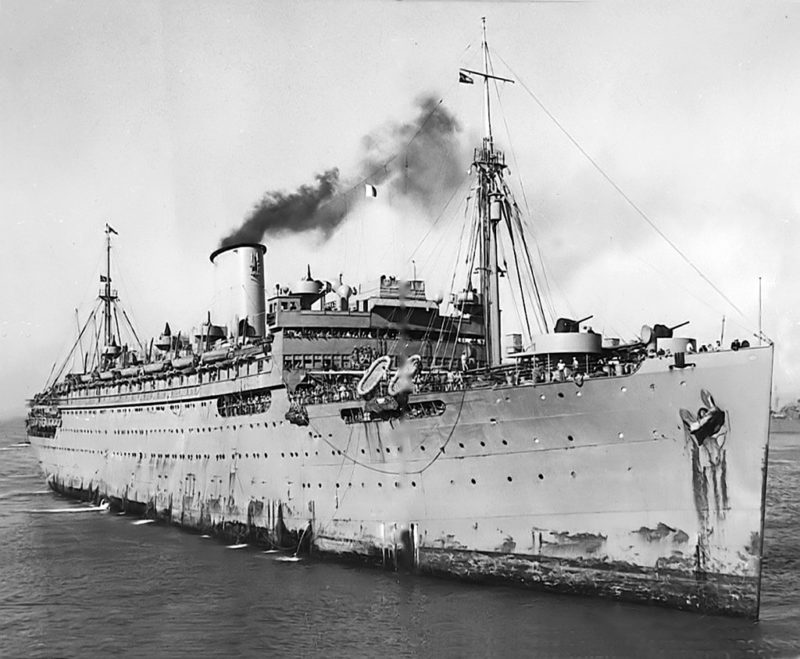
WORLD WAR II
The trio of Argentina, Brasil and Uruguay served with distinction during World War II as American troopships. Unfortunately, thirteen people were killed on Uruguay on 12th February 1943 in a collision with the U.S. Navy tanker Salamonie off Bermuda. Brasil and Argentina took part in the Operation Torch landings in North Africa during November 1942. All three troop transports trooped worldwide, including to Australia, New Zealand and to New Caledonia and other South Pacific islands.
Uruguay trooped many times across the Atlantic to British ports, as well as to Casablanca, Naples, Yokohama, and Australia and New Zealand. On one occasion in November 1944, she sailed up the Hudson river to pick up West Point military cadets in the upper Hudson, with her ballast lightened and her top masts shortened to pass under bridges.
She carried a total of 125,500 troops during the war and steamed 263,600 miles. Argentina made 56 trooping voyages with over 175,600 troops and covered 335,906 nautical miles during the war. Brasil carried infantry and engineer battalions from the Autumn of 1943 across the Atlantic to fight the war in Europe until July 1945, when she transitted the Panama Canal to make two troop voyages homeward from Manila to San Francisco. Argentina and Brasil were chartered to United States Lines between March and August 1946 to carry war brides from Southampton to New York.
Fourteen ‘C3’ Moore-McCormack Line cargo ships were converted into escort carriers for war service in the Royal Navy and U.S. Navy. These were:-
- Rio de Janeiro completed November 1941 and converted into HMS Dasher in July 1942
- Rio de la Plata completed August 1941 and converted into HMS Charger in March 1942
- Rio Parana completed September 1941 and converted into HMS Biter in May 1942
- Rio Hudson completed July 1941 and converted into HMS Avenger in March 1942
- Mormacland completed April 1940 and converted into HMS Archer in November 1941
- Mormacmail completed March 1941 and converted into USS Long Island in June 1941
- Mormacland (2) completed 1942 and converted into HMS Pursuer in 1942
- Mormacgulf completed 1942 and converted into HMS Chaser in 1942
- Mormacmail (2) completed 1942 and converted into HMS Tracker in 1942
- Mormacmail (3) completed 1942 and converted into HMS Battler in 1942
- Mormacpenn completed 1942 and converted into HMS Hunter in 1942
- Robin Kirk completed 1943 and converted into HMS Ameer in 1943
- Robin Mowbray completed 1943 and converted into HMS Slinger in 1943
- Robin Trent completed 1943 and converted into HMS Ravager in 1943
The 7,909grt Mormacdawn was built in 1946 by Ingalls as Pasagoula. In 1970 she moved to Oswego SS Co. as Silver Gull. On 5th February 1971 she arrived at Kaohsiung to be broken up by Shyeh Sheng Huat Steel & Iron Co. Ltd. (René Beauchamp)HMS Dasher carried fifteen aircraft and was armed with three 4-inch anti-aircraft guns and fifteen 20 mm cannons. The hangar below the flight deck measured 190 feet by 47 feet and she had one aircraft lift, and fifteen arrester wires on her wooden flight deck. Dasher took part in the Operation Torch landings in North Africa along with her sister ship Biter, flying off their squadron of Sea Hurricane fighters. She embarked Fairey Swordfish torpedo bombers in the Clyde in March 1943. She then escorted one convoy successfully, but after leaving with the second convoy she developed engine trouble and put back to port. She suffered an enormous internal explosion off Ardrossan about midway to the ferry route to Brodick on Arran on 27th March 1943 and sank with the loss of 379 from her crew of 528.
HMS Charger became USS Charger only a few days after being commissioned into the Royal Navy in March 1942. She operated throughout the war as a training ship at Chesapeake Bay along with two aircraft ferry missions to Bermuda and Guantanamo Bay on Cuba. She was decommissioned in March 1946.
HMS Biter commissioned on 6th May 1942 and arrived at Scapa Flow on 1st October 1942 to join up with sister ship Avenger. The two escort carriers and the fleet carrier Victorious then sailed for the Operation Torch landings in North Africa, and on her return she sailed to Iceland as part of the 5th Support Group. On 21st April 1943, she sailed from Iceland to escort convoy ONS4 to Argentia in Newfoundland and played a major role in the sinking of two U-boats. Biter left Argentia on 5th May 1943 to escort convoy HX 237 from Halifax (NS) to Liverpool with a total of three U-boats sunk by her Swordfish aircraft and surface escorts. She was then ordered to escort convoy SC 129 homeward after leaving HX 237 with another U-boat attacked on the surface, and this convoy reached Britain on 16th May 1943 without loss. Biter was ordered to the Clyde, escorting other convoys, until she sailed again on 19th October 1943 to escort westward bound convoy ON 207 for Argentia, Canada. She then escorted homeward convoy HX 265 and sailed with the 7th Escort Group around 60 miles ahead of the convoy to detect the waiting U-boat wolf pack.
One U-boat was reported as damaged, but Biter was badly damaged at the stern when a Swordfish aircraft crashed into the sea with its torpedo detonating on the rudder. After four weeks of repairs, she continued her North Atlantic convoy escort duties until transferred to the French Navy as the escort carrier Dixmunde, which served in several campaigns in French Indo China between 1945 and 1949.
HMS Avenger commissioned on 2nd March 1942 and took part in the successful escort of the Russian convoy PQ18 in September 1942, with one U-boat sunk and many enemy aircraft shot down. She then took part in the Operation Torch landings in North Africa in November 1942 flying sixty fighter missions, but while returning she was sunk by U-155 on 15th November 1942, only nine hours after leaving Gibraltar with the loss of 516 men from her crew of 555.
HMS Archer was commissioned on 17th November 1941 and earned the Battle Honours of North Atlantic 1943-1944 and Biscay 1944. She had no island structure on the long flight deck, this being under the starboard side with only her navigation mast above the flight deck. Unfortunately, Archer was plagued with mechanical defects to her engines, steering gear and gyrocompass, and also unfortunately had a collision that sank the U.S. cargo ship Bravos in January 1942. She then escorted a convoy to San Juan (Puerto Rico) and followed this by transferring her aircraft to fleet carrier Victorious at Freetown. She took part in the Operation Torch landings in North Africa in November 1942 carrying 30 aircraft and U.S. troops to Casablanca, and was then refitted at Liverpool with her flight deck lengthened by fifty feet. In May 1942, Archer was on escort duty with convoys ONS 6, ON 182 and HX 239 from a base in Iceland with the 4th Escort Group with U752 sunk by rocket attack. She was withdrawn from the 4th Escort Group to take part in operations in the Irish Sea and Bay of Biscay, but her service career was cut short due to extensive defects, and she was decommissioned in the Gare Loch on the Clyde on 6th December 1943. She was used as an accommodation ship, and later as an aircraft ferry ship. HMS Archer was the first of no fewer than 38 ‘C3’ type U.S. built and converted escort carriers commissioned into the Royal Navy between 1941 and 1944.
USS Long Island was commissioned on 2nd June 1941 and took part in escorting convoys to Newfoundland before transferring to Pearl Harbour and Task Force 1 to provide air cover for battleships and warships off West Coast ports. She took part in the Battle of Midway, and then launched her aircraft from a position 170 miles south east of Guadalcanal for Henderson Field on that island, with the aircraft massively involved in the success of the Guadalcanal and Solomon Islands campaigns. She returned to San Diego on 20th September 1942 to train pilots for one year, and later transported aircraft to forward islands in the Pacific, and then was part of the happier Operation Magic Carpet after VJ Day transporting troops and Navy crews back home to the West Coast.Four ‘C3’ Moore-McCormack cargo ships were converted into troopships and renamed:-
Mormacstar renamed as Elizabeth C. Stanton (AP-69) and earned four ‘Battle Stars’ for the Operation Torch landings in North Africa, the invasion of Sicily, the invasion of Southern France and the D-Day invasion at Normandy. She then sailed to the South Pacific and arrived at Espiritu Santo on 23rd February 1945, and carried troops to the central and southern Pacific area of the Solomon Islands, New Hebrides, Mariana Islands, Marshall Islands, Caroline Islands and Okinawa. She arrived back at San Francisco for repairs on 11th July 1945 and carried her Japan occupation troops in August 1945. She carried 1,800 German prisoners of war and their guards from Long Beach to Liverpool and Le Havre in January 1946, and returned to New York on 5th March 1946 for decommission.
Mormacsun renamed as Florence Nightingale (AP-70) and earned four ‘Battle Stars’ for the Operation Torch landings in North Africa, the invasions in Sicily and Southern France, as well as the invasions of Pacific islands at the Marianas, Guam, Eniewetok and Okinawa. She transported the German V2 rocket scientists from Le Havre to New York in November 1945, and German prisoners of war from Long Beach to Liverpool in February 1946, and carried her last returning G.Is. from Le Havre to New York, arriving on 6th April 1946 for decommission.
Mormactide renamed as Lyon (AP-71) and earned five ‘Battle Stars’ for her part in the Operation Torch landings in North Africa, Sicily, Italy, Southern France and the invasion of Okinawa in February 1945. She continued to supply Okinawa with troops and ammunition until July 1945 and then returned to Guam and U.S. West Coast ports on 14th August 1945 and was decommissioned in May 1946.
Mormacyork renamed as Anne Arundel (AP-76) and earned five ‘Battle Stars’ for her part in the Operation Torch landings in North Africa, Operation Husky invasion of Sicily, the D-Day landings in Normandy, and the invasion of Southern France. She then moved to the Pacific theatre and arrived in Pearl Harbour on 20th January 1945, carrying troops to Guam and Ulithi and taking part in the invasion of the Ryuku Islands in April 1945. She was at Okinawa on 3rd May 1945, lying offshore for five days, then at Saipan on 12th May 1945 and at Leyte until 8th August 1945. After the Japanese surrender in August 1945 while she was at Manus, she arrived at Yokohama on 13th September. Four days later she sailed for Apra Harbour on Guam, and carried troops to Tsingtao (China), Manila (Philippines), Hai Phong (French Indochina). She left Chinese waters on 14th November 1945 and proceeded to Nagoya in Japan, and arrived back at Tacoma on 18th December 1945 with her last returning military personnel. She decommissioned at Brooklyn on 21st March 1946 having been on active war duty from 17th September 1942.
The Attack Troop Transports Leonard Wood (APA-12) and Hunter Ligget (APA-14) were built in 1922 to the Emergency Fleet Corporation design 1029, more commonly known as the ‘535’ as this was their overall length in feet, as Nutmeg State and Palmetto State. They were owned by Moore-McCormack Lines between 1938 and 1939 and were then requisitioned for war service. Leonard Wood (ex Nutmeg State) earned eight ‘Battle Stars’ during the war at the invasions of North Africa, Sicily, Gilbert Islands, Marshall Islands, Saipan, Palaus, Leyte (Philippines) and Mindoro Island (Philippines). Hunter Ligget (ex Palmetto State) earned four ‘Battle Stars’ for the invasions of Guadalcanal, Bougainville and two other Pacific islands.
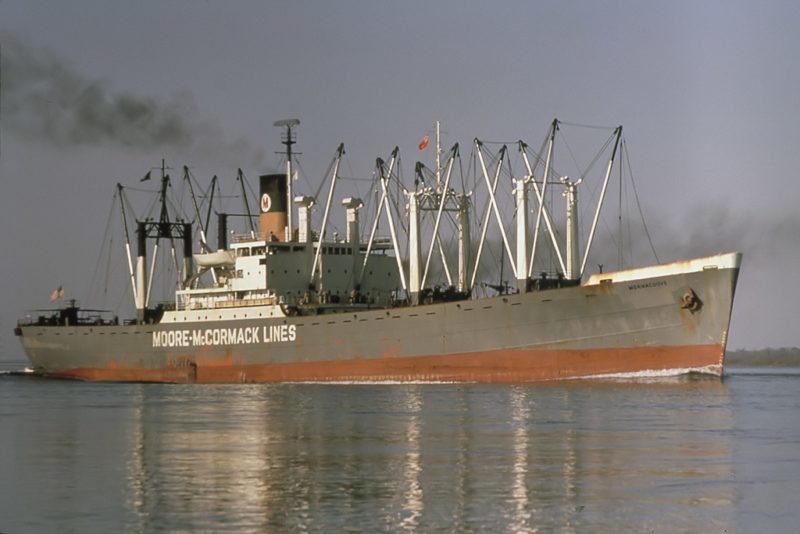
Moore-McCormack cargo ships that were lost to enemy action during the war included:-
- Collamer torpedoed and sunk by U-404 on 5th March 1942 while on a voyage from Philadelphia and Halifax (NS) to the Clyde and North Russia with war material, seven crew were lost.
- Commercial Trader torpedoed and sunk by U-558 on 16th September 1942 with the loss of four lives while on a voyage from Ceara to Trinidad with 3,500 tons of general cargo including manganese ore.
- Mormacsul bombed and sunk in convoy PQ16 on 27th May 1942 with the loss of three lives while on a voyage from Philadelphia and Reykjavik for North Russia with war material.
POST-WAR YEARS
The passenger ship trio of Uruguay, Brazil and Argentina resumed post-war service to South American ports in 1948 in Moore-McCormack Line colours after a refit to convert them into one class ships for 500 passengers. The fleet had regained its pre-war size of forty ships by 1950, with all except this trio of liners having the ‘Mormac’ prefix to their names. Uruguay had made 28 voyages to South American ports sailing a total of 350,000 miles before she was sadly withdrawn in 1954. A diversion had to be made into Newport News shipyard on 9th August 1952 to replace a bent propeller after striking a submerged object shortly after sailing from New York. A call at Fort Lauderdale was usually made in February of each year to pick up passengers for the ‘Fiesta of the Cariocas’ in Rio de Janeiro.
The Moore-McCormack Lines fleet of cargo-liners in post-war years comprised standard war built ‘C1’, ‘C2’, ‘C3’ types and four ‘Victory’ types, the latter renamed as Mormacelm, Mormacfir, Mormacoak and Mormacpine. In 1946, the fleet also had 76 chartered ships from the U.S. Maritime Commission. The T2-SE-A1 standard tanker Pequot Hill was purchased in 1948 and renamed Mormacfuel, she had been built by the Kaiser Company yard at Swan Island in Portland, Oregon. She was given a grey hull and carried fuel to major ports on the East Coast and West Coast including Vancouver, and was sold in 1965 to the Cleveland Transport Corporation of New York and renamed Cleveland. She arrived in tow on 21st November 1970 at Sveti Kajo in Split to be broken up by Brodospas.
In 1949, the company repaid a U.S. Government loan subsidising its services to South America and repaid its mortgages to obtain a fully owned fleet of 40 ships. Meredith Victory rescued some 14,000 refugees from Hungnam in North Korea in December 1950 during the Korean War.
In 1957, Robin Line of the Seas Shipping Co. Inc. with eight of their dozen ships joining the fleet of Moore-McCormack Line, while four joined the Jakob Isbrandtsen fleet of New York. This fleet kept their ‘Robin’ prefixes to their names and traded from Eastern Seaboard ports to South and East Africa. The other cargo-liners were employed on the American Republics Line, Pacific Republics Line, and American Scantic Line services. The Moore-McCormack Line fleet in 1960 totalled forty owned ships.

Fourteen new cargo-liners of 12,000 dwt with a loaded draft of 31.5 feet, that could carry containers as deck cargo bolstered the cargo services to South America, Africa and Europe during 1961/64, named Mormacaltair, Mormacargo, Mormacbay, Mormaccape, Mormaccove, Mormacdraco, Mormacglen, Mormaclake, Mormaclynx, Mormacpride, Mormacrigel, Mormacscan, Mormactrade and Mormacvega. However, the cargo handling ports of South America and Africa were nowhere near ready to handle bigger container ships as the port infrastructure would take another ten to twenty years to improve. Four ‘C5’ type combination ro-ro and container ships were completed in 1969 as the answer to this problem, as Mormacsea, Mormacsun, Mormacsky and Mormacstar, but when a North Atlantic trade war erupted in 1970, Moore-McCormack Lines made a loss of $17 million, and was forced to sell this quartet to American Export Lines (AEL).
In 1976, four ‘C4’ type cargo-liners were purchased from States Marine Corporation and renamed Mormacsaga, Mormacsea, Mormactide and Mormacwave, while the six members of the ‘Constellation’ class of cargo-liners were lengthened and converted into cellular container ships Mormacaltair, Mormacargo, Mormacdraco, Mormacrigel, Mormacvega and Mormaclynx to make them more profitable. The African service was bolstered in 1980 with the purchase of two ships from Farrell Lines, Austral Pilot and Austral Patriot, to make Moore-McCormack Lines trade as the sole American shipping company running to South and East Africa.
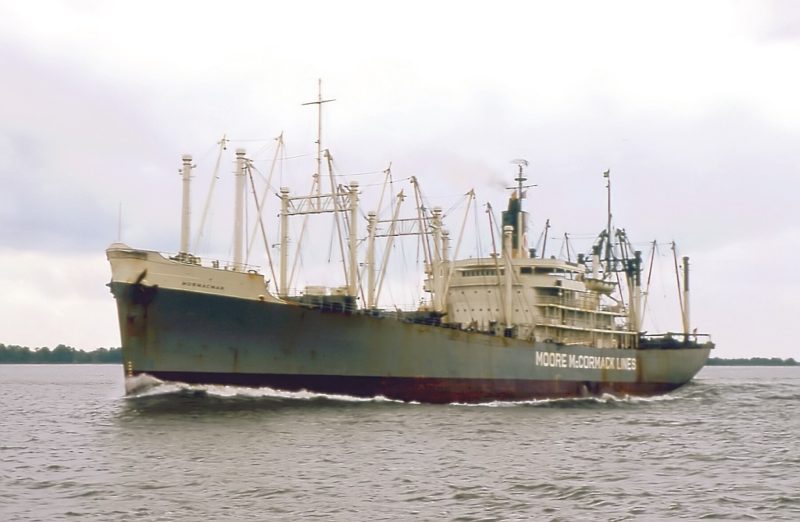
In December 1982, the sale took place of Moore-McCormack Lines Inc., one of the iconic American liner companies and their last four cargo-liners to United States Lines, run by Malcolm McLean (1913-2001), with worldwide container services. Moore-McCormack Lines Inc. had begun the first Transatlantic container service between the Eastern Seaboard of America and Scandinavia in March 1966, using general cargo ships with containers stowed on their weather decks from their fleet of 35 vessels. The efficiency of loading containerised cargo at New York was much improved, and much cheaper at only $2 to $2.5 per tonne compared to $16 per tonne for conventional break bulk cargo. The ships could not unfortunately turn this trade into a commercial success, and Moore-McCormack Lines gave up their Transatlantic service in 1970, even though it had in fact been the first U.S. shipping line with containers on the route, and had also been heavily subsidised by the American Government for many years. Moore-McCormack Lines Inc. did not follow up quickly enough with cellular container ships, while their U.S. competitors did.
It was fitting that Malcolm McLean should take over Moore-McCormack Lines, as on 26th April 1956, the first vessel to obtain U.S. Coastguard approval to ship containers was his converted tanker Ideal-X for a service from Port Newark to Houston. Malcolm McLean ran his Pan-Atlantic and Waterman companies for many years eventually taking over United States Lines. He is the acknowledged ‘father’ of the now huge container industry, although he was not the inventor of the shipping container. On the morning of his funeral on 30th May 2001, many of the container ships in the world saluted him with a fanfare on their sirens.
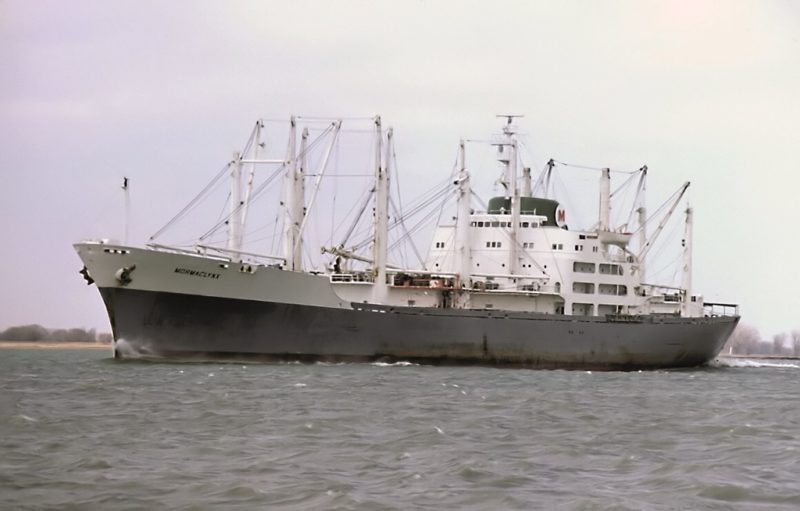
Moore-McCormack Resources Inc., the division operating in the oil, mining and construction fields, continued the famous name and controlled several small vessels in the Great Lakes area. This company had been set up in the early 1970s to diversify away from shipping, with three tankers of 39,860 dwt named Mormacsky, Mormacstar and Mormacsun completed in 1975/76 by the National Steel & Shipbuilding Corporation (NASSCO) yard at San Diego. The trio were registered under Moore-McCormack Bulk Transport Inc., which continued to trade until 1987 when it was sold to a former Chairman of the company, James R. Barker, who set up Mormac Marine Group Inc. to operate the trio until they were broken up during 2001 and 2002
THE LAST MOORE-McCORMACK PASSENGER LINERS BRASIL and ARGENTINA (2)
Two new very stylish, intermediate liners replaced the retired Brazil and Argentina in 1958. The name of the new lead ship was spelled as Brasil in Portuguese fashion at the request of the Brazilian Government. The new pair of liners were built at a cost of $50 million, but were part of a large shipbuilding programme costing $400 million with new cargo-liners for the service between New York, Boston, Philadelphia, Baltimore, Norfolk, Savannah and Jacksonville and Trinidad, Rio de Janeiro, Santos, Montevideo and Buenos Aires. The original funnel colours of Moore-McCormack Lines had a black top, but this was removed to give a white base and a green top with a white disc bearing a red ‘M’ on the green part. The Commodore of the line flew the same green houseflag with a white disc bearing a red ‘M’ as the other ship masters, but his ship could be distinguished as the flag had a yellow border.
The new stylish pair were claimed to be the most luxurious liners ever built for South American service. Brasil (Yard number 467) and Argentina (2) (Yard number 468) had a sailing schedule which permitted a sailing every two weeks allowing for tourist stops at Barbados and Trinidad.
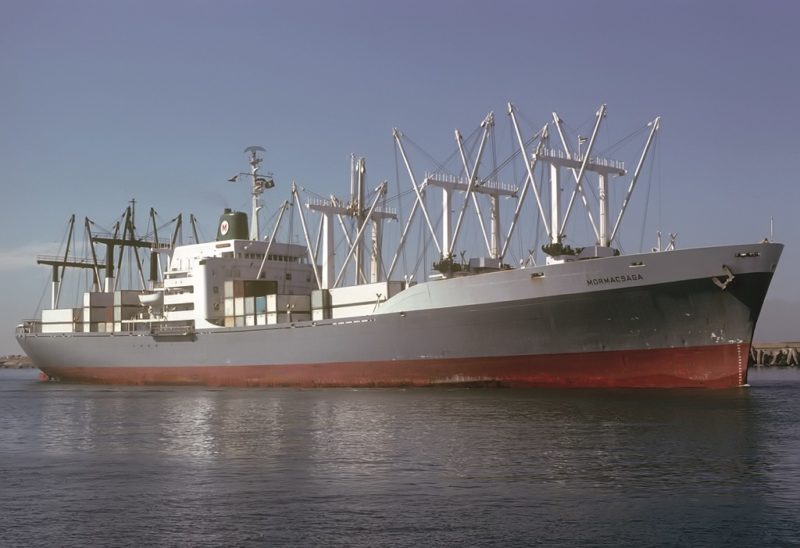
They were built by the Ingalls Shipbuilding Corporation at Pascagoula in Mississippi, one hundred miles east of New Orleans, with full air conditioning throughout and had special design features for all of her 553 First Class passengers in outside cabins. The keel of Brasil was laid on 6th July 1956 with Rear Admiral Robert C. Lee, Vice Chairman of Moore-McCormack Lines, driving home the first rivet into her double bottom section. Unusually, her plates were one inch thick and made of part high tensile steel. She was launched first on 16th December 1957 by Mrs Emmet J. McCormack and was delivered on 5th September 1958 and made her maiden arrival at New York four days later, escorted by seven tugs in a water cannon salute. A leader in the New York Herald Tribune the next day had this to say about her:-
“The new $26 million Brasil arrived here at noon on her delivery voyage from Pascagoula and received a gala welcome with flags dressed aloft. However, aboard the liner as passengers were scores of workers from the shipyard who were busy putting the finishing touches to the interior during the three day voyage from the shipbuilding yard in Mississippi. The Brasil was originally scheduled to be delivered on 5th February this year has been delayed by a series of circumstances including a steel shortage during the early stages of construction. Among the many features incorporated into Brasil to help compete against air travel, the most discussed is the solarium on the top of the dummy funnel (the engine exhausts are led through twin uptakes further aft) where passengers are able to sunbathe in the nude under tropic skies. The upper part of the funnel is divided by a partition into male and female sections.”
A company spokesman also described the pair as, “Brasil and Argentina are the only passenger ships in the world on which the discriminating passenger may get an all over tan in a solarium atop the dummy funnel, one hundred feet above the water. They are also equipped with two outdoor pools, a junior pavilion with snack bar and juke box for teenagers, a nightclub, a theatre, a deck area for dancing under the Southern Cross, and a suitable number of bars for the mature passengers. A luncheon and inspection of the new passenger accommodation for invited guests will be held onboard”.
The sisters had a length overall of 617.6 feet, beam of 84 feet, depth to Upper Deck of 54 feet, draft of 27.3 feet, gross tonnage of 14,984, displacement tonnage of 22,000 and could carry 9,470 tons of cargo. Four General Electric steam turbines of 25,500 shp received steam from three watertube boilers and drove twin propellers to give service speeds of 21 knots and achieved almost 24 knots on trials. They had four decks for passengers named Boat Deck, Promenade Deck, Upper Deck and Main Deck. There were six derricks of five tonne capacity on the forward masts for cargo handling at holds one and two, and one ten tonne and one five tonne derrick on the mainmast.
A feature of the cargo handling equipment was two side cranes for loading and unloading vehicles and general cargo on each side of the ship. They were installed on ‘C’ Deck, below Main Deck, in numbers four and five holds and consisted of a crane body and two booms, which could be extended through side ports on either side and had an outreach of 18 feet six inches. Wooden or metal pallets for general cargo, and strong slings for vehicles were attached to the booms by ‘strongbacks’. The side cranes were each operated by one man from one of two cabs to port and starboard.
Denny Brown stabilizers reduced their roll from thirty degrees to three degrees to give passengers the comfort and ease to enjoy their voyage and to ensure the vessel arrived on time. The stabiliser fins were angled by small gyroscopes with a working angle for the fins of twenty degrees, and thirty degrees for the angle of the attached tail flaps. The arrangement of the First Class staterooms and public rooms was as follows:-
Boat Deck had 36 staterooms and a deck café balcony, which overlooked the swimming pool on Promenade Deck below. There were eight lifeboats and beautifully finished outdoor teak decks. The Sun Deck above had a spacious wheelhouse forward with chartroom behind to starboard and fire control station to port. Ten cabins for the Master and Deck Officers and the Officers Lounge, the Radio Room, Ship’s Office, and battery room completed the Sun Deck, with a radio room, generator room and dog kennels built into the base of the funnel. The upper part of the funnel consisted of a solarium and an observation lounge.
Promenade Deck had a central Gift Shop forward with the Library to starboard and a Writing Room to port. Moving aft of the Entrance Hall and Foyer was a small central Quiet Lounge with Card Room to port and Ladies Powder Room to starboard. Moving aft and occupying two thirds of the length of Promenade Deck was the Social Centre Lounge, which as its names implies was the social hub of the ship. The bandstand for the ship’s orchestra was to starboard and a bar to port at the rear of this fine room, which was equipped with stylish modern tables and chairs and had long Caribbean murals showing tropical forest scenes as well as lattice patterned decorations on its walls. An open Deck Café was abaft the Social Centre Lounge with a central buffet forward of the swimming pool.
Upper Deck had 80% of its length occupied by First Class Staterooms with a children’s playground aft to port and a snack bar and junior pavilion aft to starboard and a second indoor swimming pool. The junior pavilion was very popular for dances held for the teenagers and young people onboard. The air conditioned, spacious staterooms were mostly designed for family travel, with two fold away beds for children as well as larger beds for the parents, as well as solid, wooden furniture and fittings.
Main Deck had all of its length occupied by First Class Staterooms except for the spacious central Dining Room, which occupied the starboard side of the deck. This large open pleasant room was cleverly split into several separate serving areas by tall pillars, waist high banquette seating, and serving bays. There were always flowers on every table, whether they were for two, four, six or eight guests. Interesting floral murals and wooden lattice decorations on the walls gave a stylish and modern look to the Dining Room. White melamine impregnated wallpaper gave a soft matt finish to the walls of all of the public rooms. A theatre with a projection room for conversion into a cinema was situated on ‘C’ Deck below Main Deck, and was much refurbished in their later careers to become a major feature of the twin sisters. ‘C’ and ‘D’ Decks also had the accommodation for 366 crew members
The 39,861dwt tanker Mormacstar was built in 1975 by National Steel at San Diego. In 2002 she was renamed Morma for her final voyage to Alang where she arrived on 27th July. (C. Reynolds collection)In reality, the stylish sisters were built too late for the South American passenger trade and gave only ten years of service to Moore-McCormack Lines before air travel began to take over the trade completely. Their 31 day South American voyages, marketed as cruises, were interspersed throughout this decade with other cruises e.g. five week cruises to Scandinavia, the Baltic including Leningrad where passengers saw the build up of missiles and armaments bound for Cuba, the North Cape of Norway, nine week cruises around Africa returning via the Mediterranean and the North Atlantic, and a number of short distance cruises to Bermuda, Nassau, Florida and the Caribbean. Passenger fares in 1960 for an eleven day voyage to Rio de Janeiro ranged from $595 to $1,960, and sixteen days to Buenos Aires ranged from $675 to $2,375. On the retirement of Brasil in 1969, passenger fares had increased to $1,310 and $3,075 for the 32 day round voyage to South America, and a fabulous Round the World cruise had to be cancelled due to lack of customers.
A complete rebuild of the twin liners took place in 1963 with a Federal Government grant of $2 million, with the forward superstructure heightened, the top deck extended with 61 new cabins, an extra lounge added and the funnel reshaped. The new top deck was added to increase passenger capacity to 610 passengers, and the nude sunbathing facility in the funnel was abandoned. The refit was carried out at Baltimore by Bethlehem Steel to give a gross tonnage of 15,257. A luncheon and inspection of the enlarged passenger accommodation was held at Pier 97 on the North River in New York City on Wednesday 26th June 1963 onboard Brasil by Moore-McCormack Lines Inc. However, passenger satisfaction declined due to the increased passenger load with two sittings in the Dining Room instead of one previously. The small ship ‘sea-going club’ atmosphere was lost to the inevitable shorter week-long cruises to suit the mass market e.g. in 1967 a number of cruises were run from New York to visit Expo ’67 in Montreal. This route also proved to be their last Moore-McCormack cruises with the final one in September 1969.
High American crew costs and frequent American strikes of stevedores disrupted their schedules causing long spells of lay-up, instead of making money on cruises at sea, and despite a joint marketing venture in 1968 with Moore-McCormack Lines joining with Grace Line for South American trading, the twin liners were laid up in September 1969 at Baltimore, where they remained nested together at the Maryland Shipbuilding and Dry Dock Company for the next three years. No American buyers were forthcoming, and clearance was obtained from the Government to sell the pair abroad to Holland America Line.
The stylish pair arrived at Bremerhaven at the Hapag-Lloyd shipyard in the late summer of 1972 for six month conversions at a cost of 15 million Deutschmarks each into luxury liners for long, exotic cruises. The forward cargo handling masts and derricks were removed, and a horizontal interconnecting walkover added to join the twin engine uptakes with a small vertical mast added to the horizontal walkover in the manner of Rotterdam of 1959.
Brasil was renamed Volendam and Argentina as Veendam, and they now cruised with 675 passengers from New York with gross tonnages of 23,395. They were registered at Willemstad in Curacao and positioned at New York for cruising to the Mediterranean. Veendam took the Holland America Line Round the World cruise in January 1974, preferred because of her style and luxury to the larger and more established Rotterdam of 1959 and Statendam of 1957 and modernised in 1972. Veendam and Volendam were given dark blue hulls with a white navigation mast and twin white engine uptakes, and a reddish orange funnel bearing the Holland America Line green, white and green houseflag.
However, both were heavy on fuel on these long distance cruises, and the price hike of fuel oil by OPEC producers in the Middle East at the end of 1973 meant that both had been laid up together by May 1974 at Newport News. In December 1974, Veendam, the former Argentina, was confusingly renamed Brasil for a five month charter to a Brazilian tour company for cruises from Rio de Janeiro.
Fortunately, she regained her name of Veendam, when both were chartered to the Miami based Greek owned Monarch Cruise Line for $5,000 each per day in the summer of 1975. Volendam was renamed Monarch Sun and Veendam as Monarch Star, with Dutch Captains, Greek Navigating and Engineer Officers, and American stewards and English used as the only method of communication. The pair resumed full Dutch crews in early 1978 when the ailing Monarch Cruise Line was purchased, and the pair returned to Holland America Line service as Volendam and Veendam.
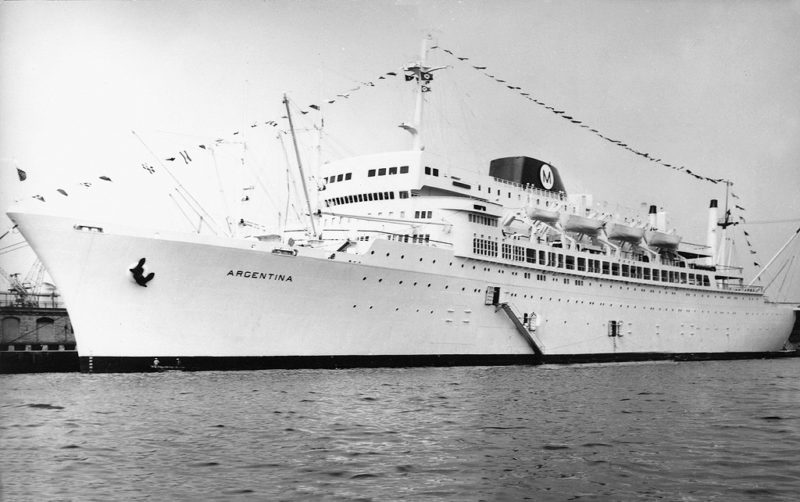
However, the stylish and new Holland America pair of Nieuw Amsterdam and Noordam of 1983/84 resulted for a short time in lay-up for the American built pair, before Volendam found employment in the St. Lawrence as an accommodation ship before both were sold to the expanding C.Y. Tung empire of Hong Kong. Volendam was renamed Island Sun and arrived at Sasebo on 10th November 1984 for a long refit in Japan before beginning cruise service in December 1985 as Liberte on South Pacific cruises from Papeete for American Hawaii Cruises. Veendam was placed on long term charter to the British owned Bahama Cruise Line and cruised in North American waters as Bermuda Star. She was then bareboat chartered by Common Brothers of Newcastle upon Tyne, better known as tramp ship operators, in May 1984, and arrived at Hampton Roads on 24th April 1984 from Tampa for a refit.
The Newcastle firm of Common Brothers had entered the cruise market in November 1980 with the purchase of the former Theodor Herzl, then trading as Veracruz 1. Bermuda Star cruised on the New York to Bermuda route in summer and New Orleans to Mexican and Caribbean ports in winter. Veracruz 1 fell off the blocks in a dry dock in Norfolk (Va) in September 1984, and the subsequent loss of confidence in her by passengers took two years to restore. Bahama Cruise Line was renamed as Bermuda Star Line in 1986.
In February 1987, 40.9% of the Common Brothers 100% shareholding in Bermuda Star Line was sold to American public investors, and with the proceeds a third cruise ship was added. This was the former Brasil, renamed as Canada Star and then Queen of Bermuda, and half owned by Common Brothers. Canada Star now had a different funnel with a raised top on its rear side, and an extended Promenade Deck forward below the bridge. She cruised in summer from New York to the St. Lawrence and in winter from New Orleans to Mexican and Caribbean ports. She had a white hull and white funnel bearing the Bahama Cruise Line logo, whereas Bermuda Star sailed with a black hull and black engine uptakes and a white funnel bearing the same logo.
Common Brothers (U.S.A.) Ltd. was established because of the increasing importance of New York as a world shipping centre, with agency, ship management and ship maintenance activities. The accounts for Bermuda Star Line Inc. with offices in Teaneck (New Jersey) for the year ended 30th June 1988 showed a loss of $1.1 million, despite a profit of $1.381 million being generated in the first half of the year, but then severe losses were accumulated in the second half. Bermuda Star, which was on a short term charter from her third party owner, was acquired by Challenge Shipping Ltd., a Group member, in August 1988 and chartered to Bermuda Star Line Inc. for five years from 1st January 1989. Bermuda Star Line Inc. now had control of three cruise ships with a total passenger capacity of 2,200.
This period of Common Brothers ownership and management of the stylish former American twins came to an end in May 1989, when the owned Bermuda Star Line Inc. was sold to Effjohn International (Johnson Line and EFFOA of Finland) for just over $20 million. Norex, the Common Brothers holding company, received $4.4 million after tax and other charges were paid. The sale gave the cruise line a major cash injection as well as withdrawal from a market in which it could no longer realistically compete with the megasize cruise lines. Commodore Cruise Line of Florida then chartered both of the stylish sisters and renamed them as Enchanted Isle and Enchanted Seas. Caribbean cruising with Commodore Cruise Line continued through the first half of the 1990s for the stylish twins. Large casinos with slot machines had been fitted as well as gymnasiums, saunas and massage parlours, with the public rooms now decorated in pleasing colours, and the 290 outside and 76 inside cabins had been updated.
In February 1996, Effjohn International sold the Commodore Cruise Line to International Cruise Finance Ltd., a group of American investors, for $32.8 million. Enchanted Seas, ex Brasil, was renamed Universe Explorer for education voyages under the auspices of Pittsburgh University. Both she and Enchanted Isle ex Argentina were now managed by V Ships Inc. (U.S.A.), a subsidiary of V Ships of Monaco, an international ship management company managing over 120 ships. Commodore Cruise Line still owned both of the stylish twins and their management contract for all technical and hotel services with V Ships was extended for another five years in July 1998.
Universe Explorer underwent a refit from October 1995 to January 1996 and then carried out a ‘shakedown’ cruise with cruise passengers to the Caribbean before beginning her educational voyages. She was given a white hull with a thin blue line at weather deck level, and a dark blue funnel with a thin yellow band, and the bridge top was also painted with dark blue and yellow bands. She then interspersed these worldwide educational voyages with Alaskan and Pacific cruises with normal full fare cruise passengers. She suffered a very bad fire in her laundry room on 27th July 1996 twenty miles off Juneau during an Alaskan cruise from Vancouver. Five crew unfortunately lost their lives, and 55 others and one passenger suffered smoke inhalation while trying to fight the fire. The fire was extinguished in four hours and the passengers were evacuated at Juneau, and the repair bill for the ship at Vancouver came to $1.5 million.
Universe Explorer then continued sailing on worldwide educational voyages under charter to the Institute of Shipboard Education and World Explorer Cruises. She left American shores for the last time from Puget Sound and Seattle for a refit at Hong Kong on 28th April 2004. The refit in Hong Kong was to create a very special Lounge in the style of the old Moore-McCormack Lines, something that cruise lovers with a true sense of history would appreciate. However, half way through this refit, her owners decided that time had caught up with the old liner and she departed from Hong Kong on 19th November 2004 under the name of Universe for the scrapyards of Alang in India, where she was beached on 7th December 2004. She flew the North Korean flag for her final voyage and was registered at Wonsan.
The former Argentina had a short spell as a temporary floating hotel named Commodore Hotel for Commodore Cruise Line at St. Petersburg during 1993/94 and was then reactivated, and continued cruising with Commodore Cruise Line from 1995 as Enchanted Isle. In Spring and Summer 1997, she was sailing from New Orleans on seven day cruises on two Caribbean routes to either Playa del Carmen, Cozumel, Grand Cayman and Montego Bay in Jamaica, or Playa del Carmen, Cozumel, the Roatan islands and Puerto Cortes in Honduras. Prices for both cruises ranged from $948 to $1,598 depending on cabin size. In late December 2000, her seven day weekend cruises were cancelled and the company filed for Chapter XI protection.
After the bankruptcy of her owners she was laid up at Violet (Louisiana) near New Orleans, the very last cruises having been seven day Caribbean cruises from New Orleans. In July 2003, she was sold to Global Marketing Company of Kingstown (St. Vincent) and was renamed New Orleans. Despite trying to find gainful employment for the old liner, she remained in lay up until her departure from Violet on 2nd October 2003 for Alang in India, where she arrived on 9th December 2003 for breaking up. Demolition was completed during the first half of 2004 with only a pile of steel left on the beach in July 2004.
The long lived stylish American twin liners had graced most of the seas of the world for over 46 years and had gained an excellent reputation for comfort and luxurious style with the vast majority of their many passengers.
They had outlasted their original owners of Moore-McCormack Lines by thirty years.

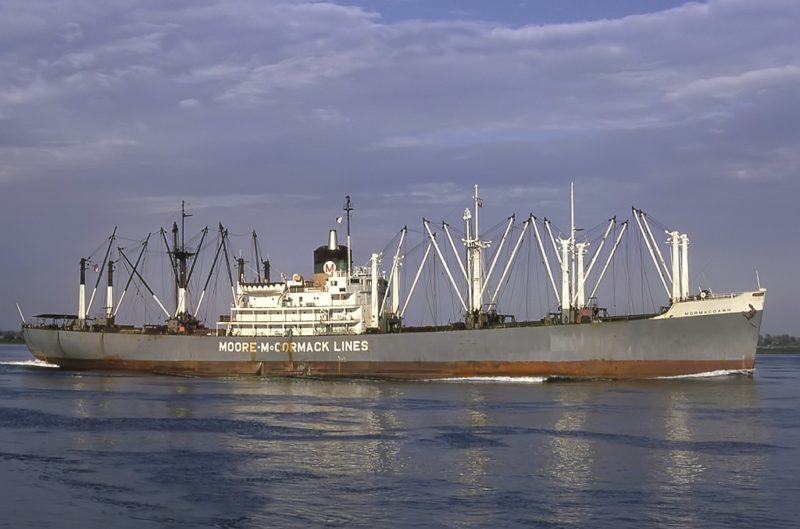
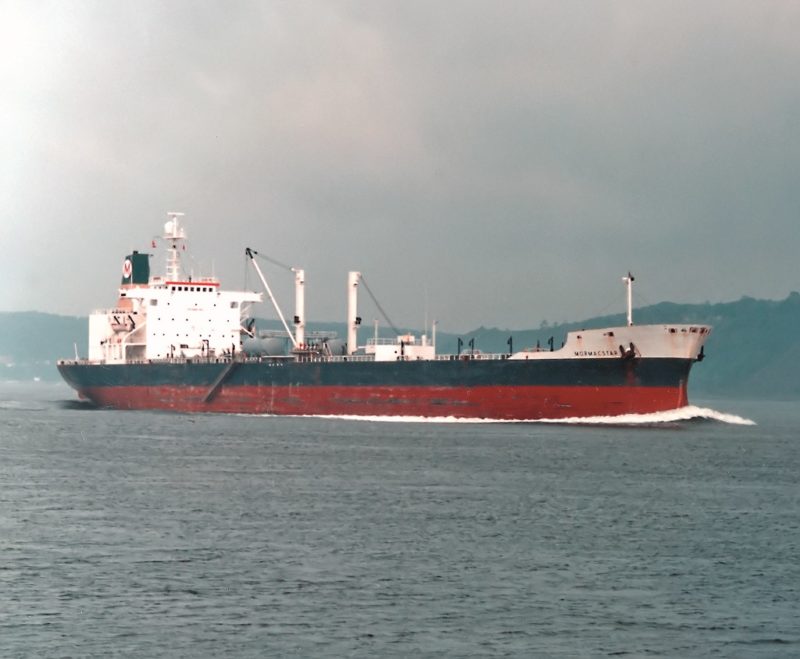
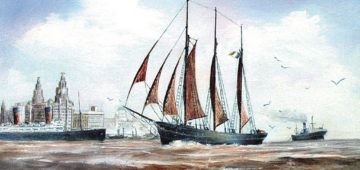



Comments
Sorry, comments are closed for this item